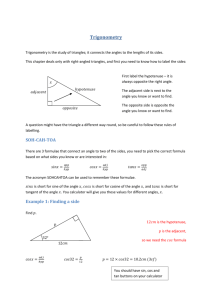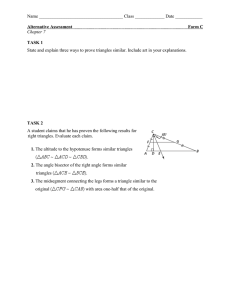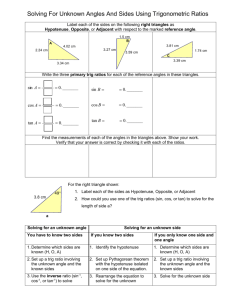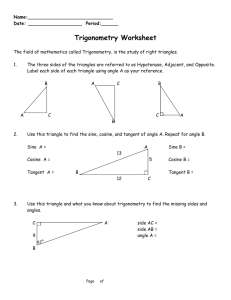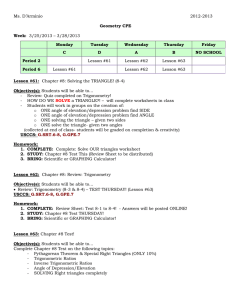Scheme of work – Cambridge IGCSE Mathematics (US) 0444
advertisement
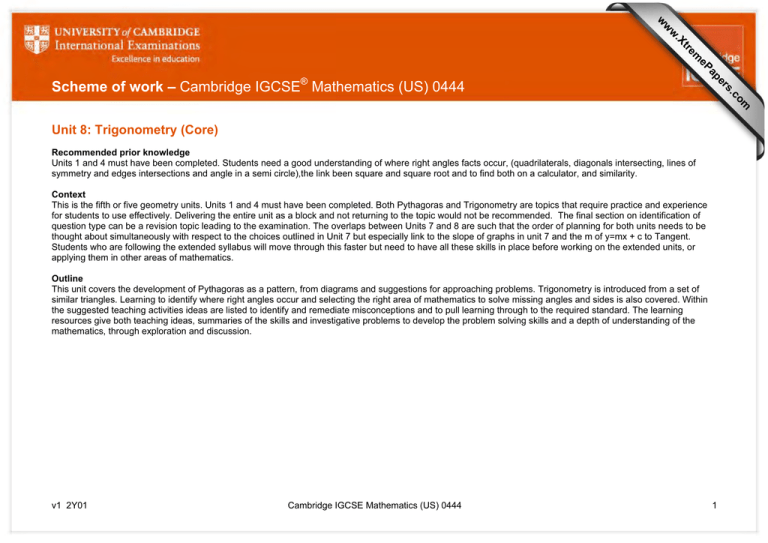
om .c s er ap eP m e tr .X w w w Scheme of work – Cambridge IGCSE® Mathematics (US) 0444 Unit 8: Trigonometry (Core) Recommended prior knowledge Units 1 and 4 must have been completed. Students need a good understanding of where right angles facts occur, (quadrilaterals, diagonals intersecting, lines of symmetry and edges intersections and angle in a semi circle),the link been square and square root and to find both on a calculator, and similarity. Context This is the fifth or five geometry units. Units 1 and 4 must have been completed. Both Pythagoras and Trigonometry are topics that require practice and experience for students to use effectively. Delivering the entire unit as a block and not returning to the topic would not be recommended. The final section on identification of question type can be a revision topic leading to the examination. The overlaps between Units 7 and 8 are such that the order of planning for both units needs to be thought about simultaneously with respect to the choices outlined in Unit 7 but especially link to the slope of graphs in unit 7 and the m of y=mx + c to Tangent. Students who are following the extended syllabus will move through this faster but need to have all these skills in place before working on the extended units, or applying them in other areas of mathematics. Outline This unit covers the development of Pythagoras as a pattern, from diagrams and suggestions for approaching problems. Trigonometry is introduced from a set of similar triangles. Learning to identify where right angles occur and selecting the right area of mathematics to solve missing angles and sides is also covered. Within the suggested teaching activities ideas are listed to identify and remediate misconceptions and to pull learning through to the required standard. The learning resources give both teaching ideas, summaries of the skills and investigative problems to develop the problem solving skills and a depth of understanding of the mathematics, through exploration and discussion. v1 2Y01 Cambridge IGCSE Mathematics (US) 0444 1 Syllabus ref Learning objectives Suggested teaching activities 8.1 Use trigonometric ratios and the Pythagorean Theorem to solve right-angled triangles in applied problems Notes and exemplars Problems involving bearings may be included. Know angle of elevation and depression. CCSS: G-SRT6 G-SRT8 Learning resources General guidance Know all the places where right angles occur in rectangles, squares, kites and rhombi, equilateral and isosceles triangles and where lines of symmetry bisect odd sided regular polygons, angles in semicircle and tangents to radii. (review of aspects of Unit 4). Teaching activities Set up a two way grid, ‘right angle(s)’ ‘no right angles’ along the top and ‘at a vertex’, ‘where diagonals cross’, ‘where lines of symmetry cross an exterior line’ down the side and ask students to put as many polygons as they can in the spaces. General guidance Develop understanding of Pythagoras rule and its use in finding missing sides in right angled triangles. Ensure time is given to checking that students can distinguish between problems that require the hypotenuse as the answer and those that require one of the other two sides. Teaching activities Set up a worksheet with half a dozen right angled triangles with the squares drawn on their edges, ask students to find the areas of the squares and record in a table, so that the largest square (on the hypotenuse) is in third column, smallest in first column and middle one in the second column, ask what they can deduce. Use an interactive geometry model (‘gcsemathstutor’ has one) to show it works for many cases. Ask how this would help to find a missing side and model both for finding the hypotenuse and for finding one of the non-hypotenuse sides. Use this as revision of square and square root and finding both on a calculator. The ‘teachfind’ resources are a lesson plan and two interactive spreadsheets (view at 100%) to find the next button and enable the macro. www.teachfind.com/nationalstrategies/notes-exploring-two-proofspythagoras-therom www.teachfind.com/nationalstrategies/exploring-geometric-proofpythagoras-therom www.teachfind.com/nationalstrategies/exploring-algebraic-proofpythagoras-theorem www.gcsemathstutor.com/gg-ss-pythag01.php www.mathsnet.net/dynamic/pythagoras/i ndex.html http://nrich.maths.org/1309 http://nrich.maths.org/6553 Find a bank of problems which require Pythagoras to solve them. If the right angled triangle is not shown i.e. ask students to find the area of an v1 2Y01 Cambridge IGCSE Mathematics (US) 0444 http://nrich.maths.org/851 2 Syllabus ref Learning objectives Suggested teaching activities Learning resources isosceles triangle given the lengths of all three sides. Get them Students should draw the diagrams, identify the right angle(s) and then to sort into two piles – finding the hypotenuse, finding a non-hypotenuse then solve them. Past Paper 13 June 2011 Q11 (syllabus 0580) General guidance Key skills for Trigonometry. Identifying the sides of the triangle correctly. Knowing the ratios. Identifying which ratio to use. Knowing whether to use the trig function or the inverse of the trig. function and how these are related to button presses on a calculator. Teaching activities To develop trigonometry draw a right angled triangle that fills a page of squared paper. Drop verticals inside the larger triangle between the hypotenuse and the base to form a nest of similar right angled triangles. Create a table with the base, heights and hypotenuse measured for each of the six triangles. In a further three columns ask them to divide both the adjacent and the opposite by the hypotenuse and the opposite by the adjacent (you could do all six ratios possible if you want and there is time). Discuss the fact that the ratios are almost identical going down a column for the six triangles – you can go around the room and suggest to some that you know that various answers/lengths need checking without telling them how you know. Finally show students how to do a sine-1, cos-1 and tan-1 on their calculators for the rough average value of each column (just give them the button presses without telling them why) to discover the same answer (approximately) . Finally measure the angle. After realising the angle and the results from button pressing were the same discuss what has happened and why by linking to similar triangle work if students haven’t realised that that is why it works. http://nrich.maths.org/5615 http://projects.exeter.ac.uk/csmsurvey/files/CSM10_Intro_to_trigonomet ry.pdf Past Paper 33 June 2011 Q6d (syllabus 0580) Past Paper 31 June 2011 Q10 (syllabus 0580) Finally give students the three ratios as fractions. Ask students to invent a Mnemonic to help them to remember the ratios. e.g. Silly Old Harry Caught A Herring Trawling Off America Sine, opposite Hypotenuse..... v1 2Y01 Cambridge IGCSE Mathematics (US) 0444 3 Syllabus ref Learning objectives Suggested teaching activities Learning resources Ensure students understand that the angle has to be known to identify the adjacent and the opposite. Give them a set of triangles in different orientations with the right angle and one other angle identified. And ask them to label the side opp, hyp adj or O, A H etc. Teach one method for solving all problems. 1. Label triangle (O,A,H). 2. Identify the three facts (two given, one to find) on the diagram. 3. Decide which trig ratio it is because two sides are identified on the diagram even if one is the ?. 4. Write down the statement in fraction form using the two given facts with one unknown. 5. Rearrange if necessary to get the unknown on one side of equation and the two knows on the other. 6. Decide whether to use the trig key or the inverse trig key on the calculator. 7. Solve and round to 3 s.f. Give students plenty of practice of a mixed bank of problems rather than sets of sine, then sets of cosine etc. It might be a good idea to ask students to sort a pile of problems into, ones to find the angle, ones to find the hypotenuse and ones to find one of the other sides at some stage. However, steps 1-7 are identical for all problems. Draw a 10cm circle on a coordinate grid, (centre the origin), marking off 10° angles from the origin to intersect with the circumference and noting their coordinates, Plotting the x-coordinate divided by 10 against angle, the y-coordinate divided by 10 against the angle, and the x-coordinate divided by the y-coordinate against the angle either for the first quadrant or for all 360° to give a different view of trigonometry. This isn’t essential but gives breadth. General guidance Choosing the tool to solve the problem. v1 2Y01 Cambridge IGCSE Mathematics (US) 0444 4 Syllabus ref Learning objectives Suggested teaching activities Learning resources Students can mix up four types of questions, finding a side from an area of triangle, trigonometry and Pythagoras and missing angle questions that can be solved by other angle properties so give students experience of identifying the question type. Teaching activities Print a mixture of questions, and ask students to sort them into the four types before they try solving them. They may have to do a little work on each problem to sort them and the discussion afterwards could be to identify how they decided the type. v1 2Y01 Cambridge IGCSE Mathematics (US) 0444 5
